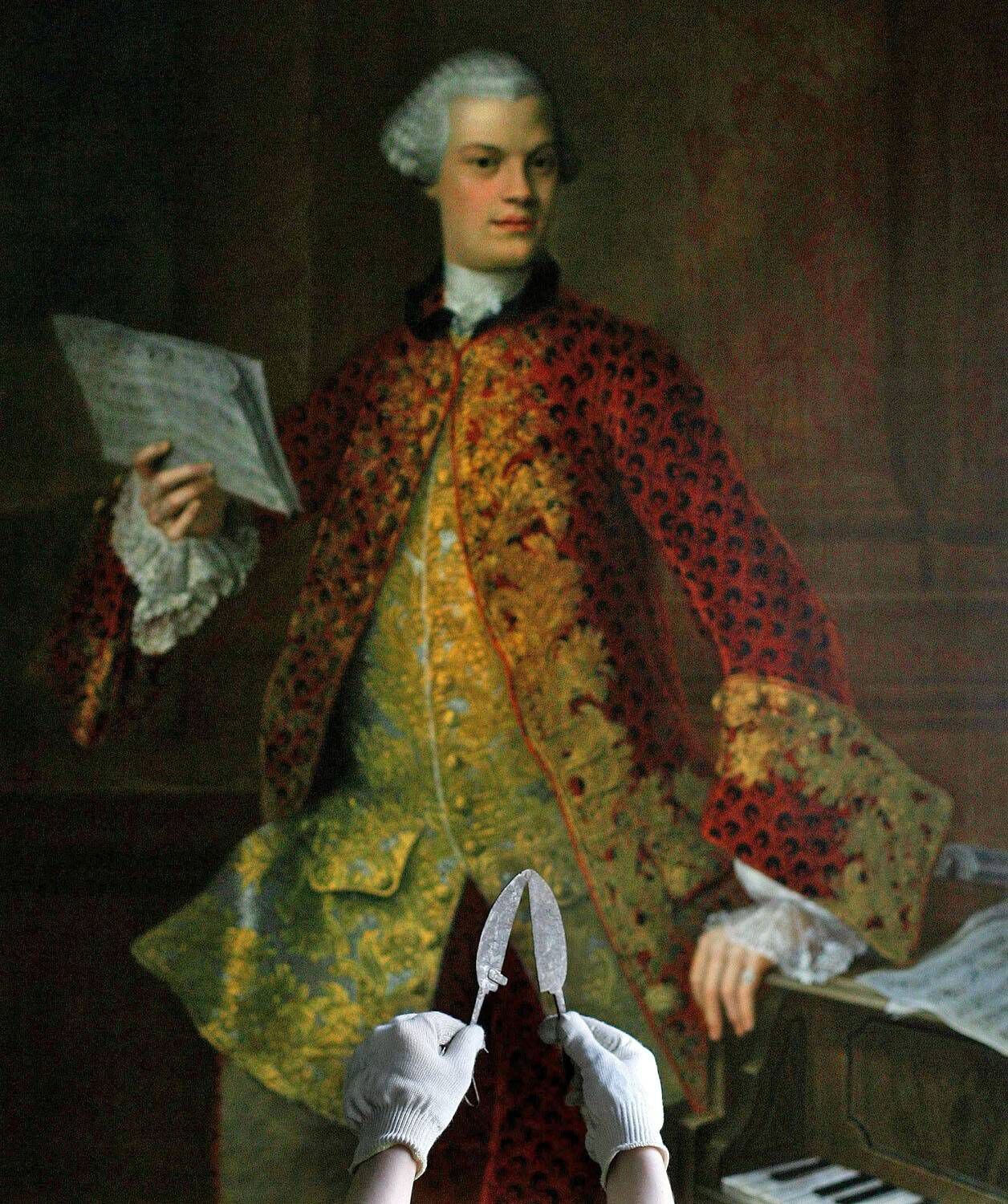The Castrato
Countertenors as substitutes for Castrati in Monteverdi’s Poppea
Today I am going to speak with you about a controversial and sensitive topic in the world of Baroque Opera, the use of countertenors as substitutes for castrati. As you know the artistic staff of LA Opera has made the bold choice to cast countertenors in two roles in their production of Monteverdi’s Coronation of Poppea. David Daniels will be playing Ottone and Christopher Gillett will be playing Arnalta. Modern audiences may question why a very manly male role like Ottone – a soldier, a lover of Poppea, would be sung in the soprano range. Even more bewildering to modern audiences is why Poppea’s caretaker, Arnalta, a woman would be played a man who sings high. So this morning I will present you with the facts of the matter, let you hear a wonderful countertenor sing, and then end it all by asking you, the audience, for your opinion on the matter.
Let’s start by defining these two strange terms, castrato and countertenor.
What is a castrato?
Castrati: male singers who were castrated before puberty in order to keep their high voice range while developing the lung and resonance capacity of a grown man. Cornelius Reid in his Dictionary of Vocal Terminology describes the castrato as: “an emasculated male singer, either a soprano or an alto.”
OK, now what is a counter-tenor?
I didn’t put a definition of countertenor on your handout today because each of the sources I checked had slightly different versions of the term so it is not easy to define in a short paragraph. The term countertenor was employed as early as the 13th century as a part writing term in early polyphony. The vocal line that went just above and counter to or against the tenor line was for a high tenor or a contratenor. Today the definitions vary but the simplest one, from the New Grove Dictionary of Music and Musicians says that countertenors are: “male high-voice soloists, who usually employ Falsetto, exclusively or in part. In different countries and periods they became titled, variously, ‘countertenor’, ‘Alto’, ‘altist’, “sopranist” ‘falsettist’, ‘Contralto’, or ‘Haute-contre’.”
Vocal pedagogues and singers disagree about the degree of falsetto use by countertenors. The famous English singer, Alfred Deller, who was a falsettist, first listed himself as a male alto, then as a countertenor. Some, like the famous counter tenor, Russell Oberlin, swear that “the counter tenor posses an unusually high lyric voice and sings in the modal register.” Use of the modal or “normal” register means that it is not falsetto. That is, his entire vocal apparatus is engaged just like that of a regular tenor or baritone. Falsettists engage only the edges of the vocal cords and often sing through an opening called a mutational chink. Russell Oberlin didn’t think countertenors used any falsetto. Richard Miller, a famous voice teacher from Oberlin College, states “A performance phenomenon that must be dealt with in any serious consideration of contemporary singing is the male falsettist. The solo counter-tenor is here to stay. It is unrealistic for teachers of singing to regard him as a nonlegitimate performer. The counter-tenor should be taught, and he should be taught seriously.”
So there we find our first controversy: the definition of a countertenor. I think any serious music professional must agree with Richard Miller that the countertenor is here to stay. Regarding how the countertenor produces that brilliant sound, well, each singer is a bit different but one can safely say that he will use the falsetto at least partially. I think we should come up with a different term for that type of sound production as it implies that the tone is somehow false. I think you will hear later that this is not the case.
Now that we have defined terms, first we will discuss the practice of castration and the uses of castrati in music history and I’ll give you a few examples.
Then we’ll talk about how countertenors fit into current versions of old operas. Finally, we’ll hear a real live countertenor perform selections of Monteverdi’s Poppea.
Cornelius Reid says that
Although the practice of castration had been common to many early civilizations, including the Roman Empire, it only emerged as an accepted social phenomenon in fourth-century Italy, when Pope Sylvester, following the edict of St. Paul to ‘let your women keep silence in church’ (I Corinthians 14:34), established the Schola Cantorum, to which boys with exceptionally promising voices were sent to be trained as choristers. The practice of castrating boys for this purpose ended shortly after the accession of Pope Leo XIII.
Pope Leo XIII banned the use of castrati in church music in 1902.
Cornelius Reid goes on to say:
The rather sexless voices of the castrati perfectly fitted the performance of early church music. However, it was soon discovered that their powerful voices were equally well suited to both the declamatory and florid styles of early opera. The castrati or evirati (emasculated ones), as they were sometimes called, soon became the operatic “superstars” of their day, complete with exorbitant fees, exaggerated lifestyles, rivalry with other singers, devoted fans, etc. All the major operatic composers of the 17th and 18th centuries, including Monteverdi, Handel, Gluck, and Mozart, wrote music for castrati; although Mozart referred to them in private as “screaming eunuchs,” In fact Monteverdi wrote the Coronation of Poppea was written for castrati to sing the lead roles.
Many castrati were notorious for outrageous behavior and became celebrated international personalities, notably Gaetano Majorano/Caffarelli (1710-1783), Francesco Bernardi/Senessino,(1686-1758) and Carlo Brochi/Farinelli (1705-1782).
Castrati were pampered, spoiled celebrities. Extremely wealthy, vain, eccentric, and well trained as musicians, they may be considered the first performers to achieve star status. Because they lost their sex genes, many of them were physical freaks, with oversized chests and skinny arms and legs. Despite their freakish appearance, many bored ladies in the early 18th century chased after them and may have been the first "groupies." Castrati were very proud of their incredible breath control and could hold a tone for a long time. Often, there were contests between a flautist or trumpeter and the featured castrato. The castrato always won. Let’s look at a clip from the 1994 movie; Farinelli:Il Castrato. This movie was well researched but no one really knows how the castrato sounded so for the film they electronically combined a counter tenor’s voice with a mezzo-soprano’s voice to create the unique sound you’re about to hear.
At the height of their popularity, castrati were the rock stars of the opera stage. Women fawned over them, threw flowers onto the stage, and fainted at their mere presence. The famous castrati knew their power and used on the stage to show their expertise at florid passages, extreme dynamic ranges, and long-held notes. Let’s look at another passage from Farinelli that illustrates this.
We don’t know how the castrato actually sounded. All we have is written accounts of how the voice sounded and one recording of an aged castrato singing “Ave Maria”. Many don’t believe that it is representative of true castrato singing because of the quality of the recording and the age of the singer.
The closest approximation to the castrato that we think we have today is either a woman or a countertenor.
The Oxford Concise Dictionary of music defines countertenor as: “ High male voice not to be confused with male alto, falsetto, or castrato and with a strong, almost instrumental purity of tone. The countertenor was popular in Handel’s and Purcells’ lifetimes and has been revived in the 20th century largely thanks to artistry of Alfred Deller. Several modern composers, including Britten in his opera A Midsummer Night’s Dream have written parts for countertenors. With the search for authenticity in performance of early music, the countertenor has reclaimed many roles in baroque works long since assigned to contraltos or tenors.”
In revivals of such works as Purcell’s The Fairy Queen, the new generation of countertenors led by Deller has played a prominent part. They have continued to take an important role in the early music movement and have increasingly shown an ability to cope with the male contralto and mezzo-soprano roles in the operas of Handel and other Baroque composers, as well as the oratorio roles originally written for the male high voice (such as David in Saul and Micah in Samson); staged revivals and recordings sometimes prefer women singers in these roles but many have favoured countertenors who have developed the volume and penetrative quality of tone necessary to project the roles in the theatre.
This movement began in Britain, with such artists as John Whitworth, Grayston Burgess, Paul Esswood, James Bowman and, later, Michael Chance; there have also been several distinguished American singers, among them Russell Oberlin, Drew Minter, David Daniels and Derek Lee Ragin, the Belgian René Jacobs, and in the 1980s and 90s several Germans, notably Jochen Kowalski and Andreas Scholl.
Modern composers of opera have also shown interest in this newly available voice. Britten wrote the role of Oberon in A Midsummer Night's Dream (1960) for Deller; this remains the countertenor's most attractive part and has been sung by several countertenors over the years. Other modern operas using the voice include Britten's Death in Venice and Glass's Akhnaten. There has also been a movement to extend the countertenor's sphere so as to include such roles as Gluck's Orpheus, , Orlofsky in Die Fledermaus and the Tsar's son in Boris Godunov; as well as Hansel in Hansel and Gretel and Cherubino in Marriage of Figaro. This has led to a generation of singers who claim dramatic qualities that dissociate it from the main British tradition emanating from Deller. And who knows what will become of the countertenor in future centuries.
Now we will hear a real live countertenor who has been studying voice for several years, as a high school student in Ridgecrest and later as a college student at Cal State LA: Kenneth Curnow. Today Kenneth has prepared three excerpts from Monteverdi’s Poppea. These excerpts are from three different roles originally written for countertenor. The first and last excerpts were written for the soprano castrato. They are Ottone and Nero, both heroic male figures, boasting of florid passages and high ranges. The middle excerpt Kenneth will sing is Arnalta’s Lullaby, a female role written for an alto castrato that shows the castrato’s famous ability to hold long notes. Kenneth will set the stage for each of the passages. The final passage has a section of music in the middle that is supposed to be sung by Poppea, but since we do not have a Poppea, Kenneth will sum up her part and then continue with Nero’s part.
So, now you have all the facts. What is your opinion? Should we use counter tenors as substitutes for castrati, transpose the men’s parts down to men’s normal ranges, cast women in the women’s roles? What do you think?

